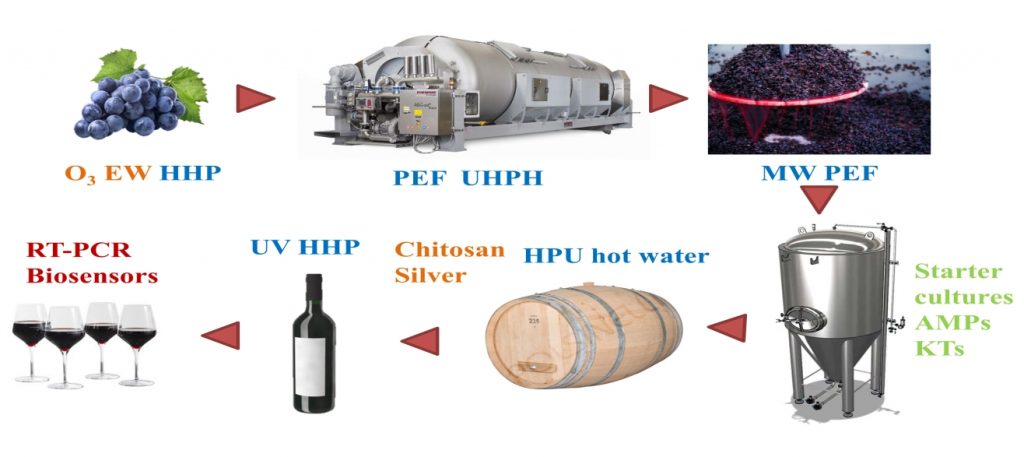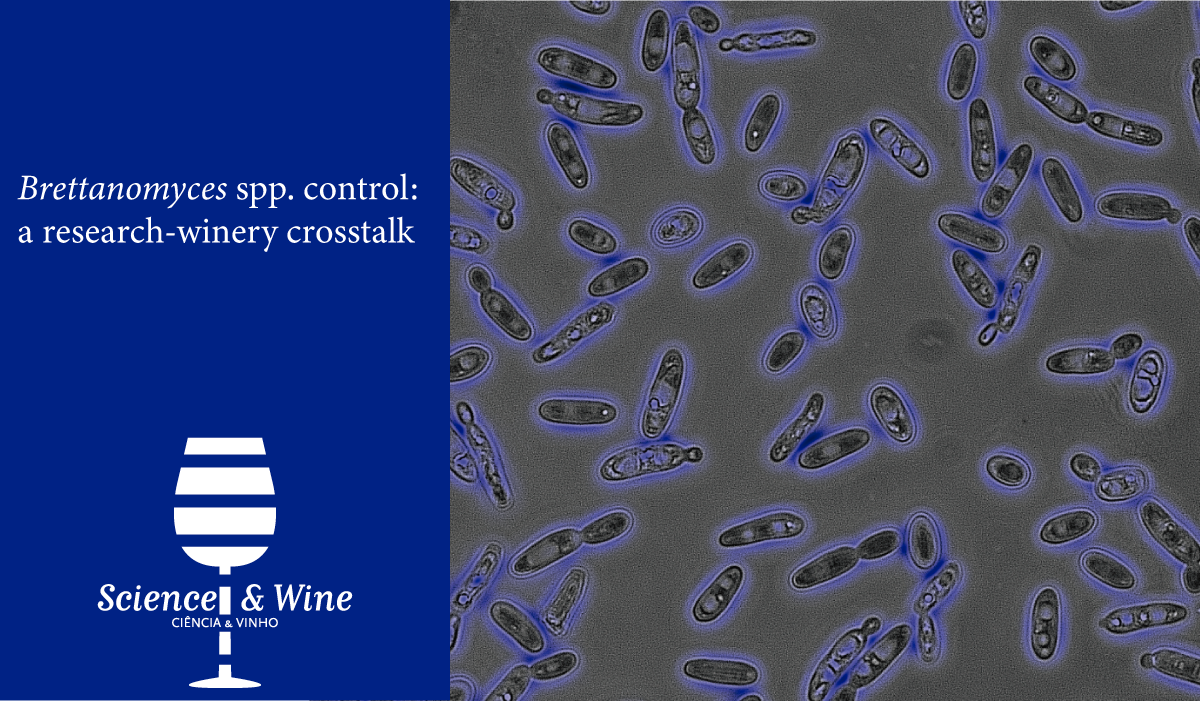By Loris Pinto, Federico Baruzzi, Luca Cocolin, and Manuel Malfeito-Ferreira
The Brettanomyces spp. contamination during winemaking and its persistence in the cellar have a detrimental effect on the high-quality wines and produce economic losses worldwide. The Brettanomyces spp. wine spoilage is largely due to the volatile phenols (VPs) production with a depreciation of the wine bottles. In the last decade, academic research explored the application of several emerging technologies in the wine sector to control Brettanomyces spp. contamination and the VPs release. The most important researches on this topic and the discussion of the obtained results have been summarized in a recent review untitled “Emerging technologies to control Brettanomyces spp. in wine: recent advances and future trends”. The review was written by Dr. Loris Pinto (CNR-ISPA, Italy) and Dr. Federico Baruzzi (CNR-ISPA, Italy) in collaboration with Prof. Luca Cocolin (University of Turin, Italy) and Prof. Manuel Malfeito-Ferreira (University of Lisbon, Portugal).
The application of these technologies is necessary in order to reduce the use of sulphur dioxide. Indeed, there is an emerging threat related to Brettanomyces spp. resistance to SO2 (Dimopoulou, Hatzikamaria, Masneuf-Pomarede, & Albertin, 2019). The emerging technologies proposed can be classified in physical, chemical, and biotechnological approaches and, as reported in Figure 1, they can be applied during all the winemaking processes.

Physical methods are used on grapes, must, barriques, and wine. Chemical methods are mainly employed on grapes at harvest or after the aging in barriques. Biotechnological tools are usually used during must fermentation. The application of physical methods such as HHP and PEF treatments effectively controlled the Brettanomyces spp. growth and the VPs production in wine. The HHP treatment (400 Mpa- 5 s) totally inactivated the B. bruxellensis cells in wine, preventing the formation of 4-ethylphenol and 4-ethylguaiacol until one year of storage after the treatment. A great inactivation rate and a lower content in ethyl-phenols were also obtained using PEF with an electric field intensity of 50 KV/cm (van Wyk, Farid, & Silva, 2018). These technologies should be combined with small amounts of SO2 in order to preserve the total phenol content, and colour density of the wine during the aging (van Wyk, Farid, & Silva, 2018). No sensory defects were detected in both HHP- and PEF-treated wines. Another physical approach, the HPU technology, combined with hot water, showed a great efficacy in the removal of Brettanomyces spp. cells from the inner part of the staves in the wood barrels (Breniaux et al., 2019). Conversely, the application of MW and UV-light to control Brettanomyces spp. contamination needs further investigation. In particular, the effect on the wine sensory properties and the reduction in the VPs production should be better evaluated.
Chemical approaches to reduce Brettanomyces spp. growth and the VPs concentration can be applied during two winemaking steps: after the grape harvest, and before the bottling. The treatment of the surface-contaminated grapes with gaseous ozone controlled the Brettanomyces bruxellensis growth during the fermentation and the production of acetic acid, vinyl- and ethyl-phenols (Englezos et al., 2019). The application of finishing agents such as chitosan and colloidal silver reduced the viability of Brettanomyces spp. yeasts in wine after their addition and during storage. However, drawbacks related to the Brettanomyces spp. re-growth or the reduction of anthocyanins and total polyphenols in wine after their application should be carefully evaluated. The application of activated carbons seems to be the best remediation strategy to remove VPs from the contaminated wines.
Innovative approaches to control the “Brett-character” in wines can be the biotechnological tools. Main strategies proposed concern the use of selected starter cultures, of antimicrobial peptides and killer toxins, or the modulation of the nutrient availability. The use of selected hydroxycinnamate decarboxylase positive (HCDC+) S. cerevisiae strains reduced the precursors of the ethyl-phenols during the alcoholic fermentation, whereas the co-inoculation of malolactic starters such as Oenococcus oeni with S. cerevisiae reduced the time-laps between the alcoholic fermentation and the malolactic fermentation, reducing the chance for the Brettanomyces spp. growth (Berbegal et al., 2018). Anitimicrobial peptide saccharomycin produced by S. cerevisiae as well as the killer toxin SeKT secreted by S. eubayanus were able to control D. bruxellensis growth in wine. The egg white addition to the wine, containing avidin or the purified protein, reduced the bioavailability of this vitamin and, as a consequence, the B. bruxellensis population by one to three orders of magnitude.
Another emerging issue is the persistance of Brettanomyces spp. cells through biofilm formation on winery surfaces. To date, the most efficient control method of the Brettanomyces spp. biofilm is the application of disinfectants based on sodium hydroxide and surfactants. As far as the Brettanomyces spp. risk assessment is concerned, novel detection methods have been proposed. In particular, the bio-sensing systems and enzymatic kits seem to meet the producer’s demand of fast, cheap and sensitive methods.
The author’s opinion is that the reported emerging technologies alone are not sufficient to control the Brettanomyces spp. contamination in the winery. Therefore the “hurdles concept”, the application of multiple technological solutions during winemaking to control Brettanomyces spp. yeasts in the cellar, is suggested to be followed (Pinto et al., 2020). The advances in the knowledge of Brettanomyces spp. biology and the related control methods will help the research-winery crosstalk, in order to limit the economic losses due to the Brettanomyces spp. contamination.
Further details can be found in the full-text article:
https://www.sciencedirect.com/science/article/pii/S0924224419310490
Dr. Loris Pinto is Research Fellow at the Institute of Sciences of Food Production, National Research Council of Italy (CNR-ISPA, Bari). PhD in Soil and Food Sciences, Curriculum Microbiology, Technology, Health and Food Chemistry. He carried out a stage at the Malfeito-Ferreira’s Lab to evaluate the interactions in a yeast-bacteria consortium responsible for grape sour rot. Current research interest is the control of spoilage microorganisms on fruit and vegetables through different technological approaches. Mail: loris.pinto@ispa.cnr.it; ORCID iD: orcid.org/0000-0001-8107-5677
Dr. Federico Baruzzi is Senior Researcher at the Institute of Sciences of Food Production, National Research Council of Italy (CNR-ISPA, Bari). His research interests deals with food microbiology, antimicrobial peptides, foodborne pathogens, food plant sanitation, microbial food spoilage and preventing methods, microbial proteolysis, probiotic bacteria, and molecular biology. He is involved in several national and international projects of the food sector. Mail: federico.baruzzi@ispa.cnr.it; ORCID iD: orcid.org/0000-0002-3586-2140
Prof. Luca Cocolin is Full Professor of Food Microbiology at the Department of Agriculture, Forestry and Food Sciences, University of Turin, Turin, Italy. Editor-in-Chief of the “International Journal of Food Microbiology”. President of the Board of Directors of EIT-Food CLC South Europe. President of the Italian Society of Agricultural, Food and Environmental Microbiology (SIMTREA). His wine research activity is focused on the selection of starter cultures, the control of spoilage yeasts, the molecular characterization of the grape/wine microbiota, and the physiology of Saccharomyces/non-Saccharomyces yeasts. Mail: lucasimone.cocolin@unito.it, ORCID iD: orcid.org/0000-0003-4799-7074
Prof. Manuel Malfeito-Ferreira is Assistant Professor at the Linking Environmental, Agriculture, and Food Research Center, Instituto Superior de Agronomia (ISA), University of Lisbon, Lisbon, Portugal. Author of several books and book chapters on wine spoilage yeasts, and active in the Brettanomyces spp. research in the period 1990-2020 (source Scopus). Current research interests cover the wine sensory properties, the consumer behaviour to different wine styles, and the wine spoilage yeasts. He is consultant of several Portuguese wineries and organizes tasting activities among wine enthusiasts.
References
- Dimopoulou, M., Hatzikamari, M., Masneuf-Pomarede, I., & Albertin, W. (2019). Sulfur dioxide response of Brettanomyces bruxellensis strains isolated from Greek wine. Food Microbiology, 78, 155-163. https://doi.org/10.1016/j.fm.2018.10.013
- Van Wyk, S., Farid, M. M., & Silva, F. V. (2018). SO2, high pressure processing and pulsed electric field treatments of red wine: Effect on sensory, Brettanomyces inactivation and other quality parameters during one year storage. Innovative Food Science & Emerging Technologies, 48, 204-211. https://doi.org/10.1016/j.ifset.2018.06.016
- Breniaux, M., Renault, P., Meunier, F., & Ghidossi, R. (2019). Study of High Power Ultrasound for Oak Wood Barrel Regeneration: Impact on Wood Properties and Sanitation Effect. Beverages, 5, 10. https://doi.org/10.3390/beverages5010010
- Englezos, V., Rantsiou, K., Torchio, F., Pollon, M., Giacosa, S., Segade, S. R., Gerbi, V., Rolle, L., & Cocolin, L. (2019). Effectiveness of Ozone against Different Strains of Brettanomyces bruxellensis on Postharvested Winegrapes and Impact on Wine Composition. American Journal of Enology and Viticulture, ajev-2019. https://doi.org/10.5344/ajev.2019.18058
- Berbegal, C., Spano, G., Fragasso, M., Grieco, F., Russo, P., & Capozzi, V. (2018). Starter cultures as biocontrol strategy to prevent Brettanomyces bruxellensis proliferation in wine. Applied Microbiology and Biotechnology, 102, 569-576. https://doi.org/10.1007/s00253-017-8666-x
- Pinto, L., Baruzzi, F., Cocolin, L., & Malfeito-Ferreira, M. (2020). Emerging technologies to control Brettanomyces spp. in wine: recent advances and future trends. Trends in Food Science and Technologies, 99, 88-100. https://doi.org/10.1016/j.tifs.2020.02.013








[…] Science & Wine: Brettanomyces spp. control: a research-winery crosstalk […]